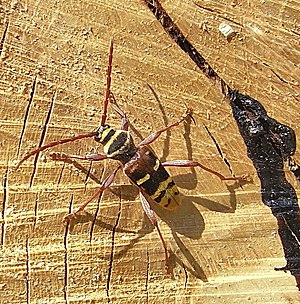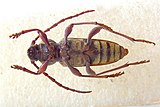Hornet buck
| Hornet buck | ||||||||||||
|---|---|---|---|---|---|---|---|---|---|---|---|---|

Hornet buck on oak wood |
||||||||||||
| Systematics | ||||||||||||
|
||||||||||||
| Scientific name | ||||||||||||
| Plagionotus detritus | ||||||||||||
| ( Linnaeus , 1758) |
The Hornets Bock ( Plagionotus detritus ), also Colorful Oak Aries Bock called, is a beetle from the family of the longhorn beetle and the subfamily Cerambycinae . The species owes its name to a certain similarity in color with the hornet. The usually rare beetles can occasionally be found en masse on felled oak trunks.
The species is listed in the Red List of Endangered Species in Germany under Category 2 (endangered). In Bavaria , Mecklenburg-Western Pomerania and Thuringia it is classified as "critically endangered", in North Rhine-Westphalia , Rhineland-Palatinate and Schleswig-Holstein it is classified as "extinct or lost". In Saxony , the beetle is rated category 3 (endangered).
Comments on the name and system
The beetle was first described by Linnés in 1758 in the famous tenth edition of his Systema naturae under the name Leptura detrita . The species name "detrita" ( Latin ) means abraded . The species was listed by Fabricius as Callidium detritrum , and when Laicharting established the genus Clytus , it was classified in this because of the rounded breast shield . Clytus is split up by Mulsant . The species that are delimited by the prothorax transverse oval , at least one third wider than long, from the species with longitudinal oval or rounded prothorax, and to which detritus also belongs, are included in the new genus Plagionotus (from ancient Greek πλάγιος plágios, transverse and νότος nōtos, back).
In Europe the genus Plagionotus is represented with eight species, worldwide with twelve species.
Characteristics of the beetle
The body reaches a length of ten to nineteen millimeters.
The head is black, but mostly hairy yellow (Fig. 4). The mouthparts point downwards at an angle, the jaw buttons are truncated. The eleven-limbed, red-brown antennae are strong. They are hairy and the second antennae is almost ring-shaped. The middle antennae are edged out at the end and angularly drawn out. The kidney-shaped eyes only cover a small part of the antenna base from behind; the distance between the bases of the two antennae is smaller than the distance between the inner edges of the eyes (Fig. 4).
The pronotum is approximately spherical and almost as wide as the elytra . It is also black, the front edge has broad yellow hairs, behind the middle a narrower yellow transverse band appears.
The wing covers are cut off at the end, the outer angle is often drawn out into a tooth (only rudimentarily in Fig. 5). The elytra are dark brown to black, but partly appear yellow due to their yellow hair. The yellow coloration is very variable, usually limited to a few spots at the base of the wing panels, it forms increasingly broader bands towards the rear and can cover the entire end of the elytra.
The legs are red-brown and more robust than those of the species of the genus Clytus . Not only the fore thighs, but also the middle and rear thighs have long protruding hairs (Fig. 3). The five-limbed tarsi appear to be four-limbed because the fourth limb is very small and hidden between the lobes of the third limb.
The roughly spherical front hips are clearly separated and for the most part enclosed by the front chest (Fig. 2)

|

|
||||
| Image 1: View from the side | Photo 2: view from below | ||||

|

|

|
|||
| Photo 3: hind legs |
Fig. 4: front view |
Image 5: wing top tip |
|||
biology
The warmth-loving species is rather rare in Central Europe. It can be found in deciduous forests, especially light oak forests and in parks, often on fathoms of freshly felled wood.
The larva develops in various deciduous trees, especially oak . The eggs are laid on the sunny side of ailing or dead trees in the lower area, occasionally higher or in thick branches. The larva initially eats in the bark, but to pupate it penetrates deeper into the wood if the bark is not particularly thick (Fig. 6, bottom right). The beetle needs one to two years to develop.
The adult beetle appears in early summer. The beetles are very lively and move quickly on the breeding trees.
distribution
The range covers almost all of Europe, the species is absent in Norway , Finland , and Ireland . The species is also not found on most of the islands of the Mediterranean and some smaller southern countries. In contrast, the distribution area extends far to the east, includes the Middle East and extends into Iran .
literature
- Heinz joy, Karl Wilhelm Harde, Gustav Adolf Lohse (ed.): The beetles of Central Europe . tape 9 . Cerambycidae Chrysomelidae . Spektrum Akademischer Verlag, Munich 1999, ISBN 3-8274-0683-8 (first edition: Goecke & Evers, Krefeld 1966).
- Adolf Horion: Faunistics of the Central European Beetles, Bd. XII . Überlingen-Bodensee 1974
- Klaus Koch : The Beetles of Central Europe . Ed .: Heinz Freude . tape 3 : ecology . Goecke & Evers, Krefeld 1992, ISBN 3-87263-042-3 .
Individual evidence
- ↑ Red lists at BioNetworkX
- ↑ C.Linnaeus: Systema Naturae per Regna tria naturae, secundum classes, ordines, genera, species, cum characteribus, differentiis, synonymis, locis. Tomus I. Editio decima, reformata Stockholm 1758 first description p. 399 No. 18
- ↑ Sigmund Schenkling: Explanation of the scientific beetle names (species)
- ↑ Sigmund Schenkling: Explanation of the scientific beetle names (genus)
- ^ E. Mulsant: Histoire naturelle des Coléoptères de France Paris 1862–1863 splitting of Clytus p.137
- ↑ Plagionotus in Fauna Europaea. Retrieved February 27, 2013
- ↑ Plagionotus at BioLib
- ↑ Plagionotus detritus in Fauna Europaea. Retrieved December 4, 2010
